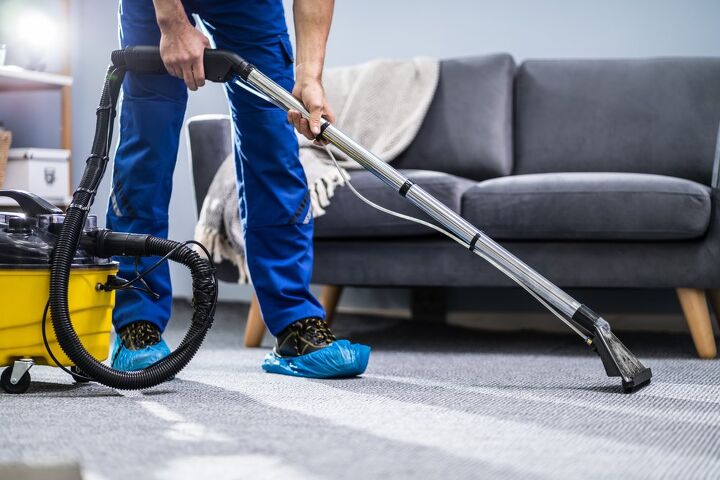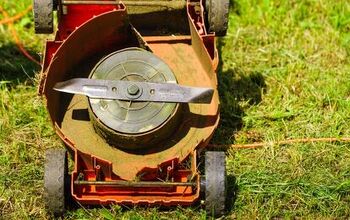5 Types Of Carpet Cleaning (With Photos)

Not sure which carpet cleaning method you should use on the carpet in your home? We’re here to help! When it comes to hiring a professional carpet cleaning company to clean your carpets, there are numerous methods that they offer. Generally speaking, carpet cleaning methods can be placed into two main categories: wet cleaning or dry cleaning. Though, that’s not all there is to it.
The most common types of carpet cleaning include steam cleaning, bonnet cleaning, encapsulation, dry carpet cleaning, and carpet shampooing. With so many choices to choose from, it’s important to understand the types of carpet cleaning methods used by different companies, as not all will work for the carpet in your home.
Each cleaning method has its own advantages and disadvantages. So, how do you know which one to choose? Continue reading for our comprehensive guide on the types of carpet cleaning methods. That way, you can make an informed decision on which is best for your carpet.
Do You Need Carpet Cleaning Services?
Get free, zero-commitment quotes from pro contractors near you.

1. Steam Cleaning
Also known as hot water extraction or wet cleaning, steam carpet cleaning uses high pressured water to disturb the carpet fibers and dissolve the dirt in the carpet. This technique includes both the use of pressurized water and a vacuum to remove dirt and debris stuck inside the carpet fibers. Steam cleaning is often considered the best and most common carpet cleaning method.
Hot water extraction usually begins with the application of a cleaning agent on the soiled carpet surface. The cleaning agent is meant to liquefy solids and oil-based substances in the carpet fibers. Then, the carpeting is agitated using a brush and followed by rinsing. After the cleaning agent is given a short amount of time to settle, the carpet is “washed” using carpet cleaning equipment.
Water is heated to a temperature near boiling point, pressurized, and then injected into the carpet. Then, the solution is extracted using a vacuum. This removes the cleaning agent thoroughly and then the carpet is left to dry completely under room or air-conditioned temperature.
To put things into perspective, an average-sized carpeted space of 3000 square feet would take about two hours to clean and approximately four hours to dry. In most cases, it’s recommended to have the cleaning done in the late afternoon so the carpet can be left to dry overnight.
Pros of Steam Cleaning
- Removes soiling deep in the carpet fibers
- Permits the use of high temperatures, chemical concentrates, and pressures.
- Allows extended stay times for cleaning agents to react.
- Chemical reactivity is assisted with a grooming tool or extraction wand.
- The most popular and widely used carpet cleaning method.
- Recommended by most carpet cleaning professionals and carpet manufacturers.
Cons of Steam Cleaning
- Somewhat lengthy drying time. Though, it can be reduced with the use of professional equipment.
- Expensive equipment necessary for optimal results.
- Relatively expensive to have done professionally.
2. Bonnet Cleaning
Bonnet cleaning is a type of carpet cleaning that provides good surface cleaning results, as the process primarily involves cleaning the top layer of the carpet fibers. While it is most commonly used for routine light maintenance, it can also be used for regular carpet cleaning. This technique involves the use of a rotary floor machine and a cleaning pad that is soaked in cleaning surface to clean the dirt off of the carpet.
First, the carpet is vacuumed and then a chemical solution is applied with an electric sprayer or hand pump. The solution sits on the carpet for a suitable reaction time before the machine is used. Then, an absorbent pad (or, bonnet) is situated on the drive block of a rotary floor machine. It is spun over the surface of the carpet at between 100 and 300 rpm.
As the machine moves over the carpet, the pad spins, saturates the fibers with the cleaning solution, and absorbs the dirt from the surface. Bonnet cleaning is very common in hotels and other commercial settings, as it is a quick fix for cleaning carpets in heavily trafficked areas, without disturbing hotel guests.
Pros of Bonnet Cleaning
- A low moisture cleaning system with a fast-drying time.
- Excellent for heavy-traffic areas that need to be cleaned fast, with minimized downtime.
- Great for removing stains that cannot be removed by vacuuming.
- Works well for light maintenance purposes and spot cleaning.
Cons of Bonnet Cleaning
- Does not clean deeply – only reaches the top one-third of the carpet.
- Dirt under the carpet will emerge to the surface within a short period of time, requiring more frequent cleaning.
- Causes accumulation of chemical residue on the surface of the carpet.
3. Encapsulation
Foam encapsulation refers to a cleaning process that uses synthetic detergents as a base that crystallizes into powder as it dries. When applied to the carpet, the cleaning agent loosens the dirt in the fibers and encapsulates it into powder as the foam dries. Once dry, the solution is vacuumed or brushed.
This method has overtaken traditional carpet shampooing methods as it uses less water. Since encapsulation uses less water during the cleaning process, it results in shorter drying times. Not to mention, with fewer chemical residue left behind, encapsulation can be seen as an environmentally friendly solution.
Although encapsulation carpet cleaning has displayed wonderful cleaning results, the technology is still somewhat limited and cannot thoroughly clean heavily soiled carpet.
Pros of Encapsulation
- Less water results in shorter drying times.
- An environmentally friendly solution.
- Beneficial for commercial and high traffic situations.
Cons of Encapsulation
- Cannot thoroughly cleaned heavily soiled carpets.
4. Dry Carpet Cleaning
Also known as compound cleaning, dry carpet cleaning is one of the most modern cleaning technologies. It has gained popularity recently because of its approval by leading carpet manufacturers, due to its effective cleaning performance and lack of drying time. This technique involves applying a cleaning compound or powder on top of the carpet and working it into the fibers with a motorized rotating brush machine.
The machine opens up the fibers and lets the compound settle at the bottom of the carpet, causing a deep cleaning effect. The cleaning compound is usually made of a biodegradable material that functions like microsponges, absorbing the dirt in the carpet. After the powder sets for about 10 to 15 minutes and does its thing, it is thoroughly vacuumed up.
Pros of Dry Carpet Cleaning
- Recommended for commercial settings that need to operate 24/7.
- Virtually no drying time. Takes only about 20 minutes before the carpet can be used as normal.
- Safe for all types of carpet.
Cons of Dry Carpet Cleaning
- Powder can get trapped in plush pile carpets, causing build-up over time.
- Can result in excessive dust accumulation in the home.
5. Carpet Shampooing
Carpet shampooing was the most popular method until technology like encapsulation and even steam cleaning was invented. The technique involves applying a cleaning agent to the carpet to help suspend the dirt and debris in the fibers. This solution is then whipped into a foam consistency and worked into the carpet using the rotating brushes on a specialized machine. After some time, the foam is removed with a vacuum.
While carpet shampooing may appear to clean heavily soiled carpeting, the main disadvantage to this technology is that it leaves behind a large amount of wet foam residue in the carpet. This residue can take a long time to dry and become sticky as it dries since no rinsing is done after the shampooing process. The rapid re-soiling of the carpet after shampooing is what makes this method less desirable than other alternatives.
Pros of Carpet Shampooing
- Easy to apply and inexpensive.
- Rotating brushes deliver excellent agitation.
- A small amount of moisture allows for quick drying.
Cons of Carpet Shampooing
- Leaves behind sticky, foam residue that leads to re-soiling of the carpet.
- High temperatures usually cannot be achieved.
- Unable to extract dirt from deep below the surface of the carpet.
- Excessive wetting can occur with equipment malfunction.
Do You Need Carpet Cleaning Services?
Get free, zero-commitment quotes from pro contractors near you.

Carpet Cleaning Tips
Choosing the proper care and maintain a consistent cleaning schedule for your carpets is important. This often spells the difference between your carpets staying clean and soft and having to replace them often. That said, follow these tips to keep your carpets looking their best for longer:
- Have your carpets deep cleaned about every 12 to 18 months. This will keep them in good shape and looking fresh. For best results, hire a professional carpet cleaning company. For larger homes, or if you have pets or children, it may be best to have your carpets cleaned twice a year.
- Cleaning your carpets weekly or every other week using an upright or handheld portable carpet cleaner can help them stay clean in between deep cleanings.
- If you want to purchase a carpet cleaner for your home, the best option will depend on the level of cleaning you desire. A carpet shampooer will only treat the surface of the carpet, while a steam cleaner will use heat to extract dirt deep within the fibers. Though, if you live in a small household, with less foot traffic and storage, renting a carpet cleaner may be a better option for you than purchasing one.
Related Guides

Jessica considers herself a home improvement and design enthusiast. She grew up surrounded by constant home improvement projects and owes most of what she knows to helping her dad renovate her childhood home. Being a Los Angeles resident, Jessica spends a lot of her time looking for her next DIY project and sharing her love for home design.
More by Jessica Stone































